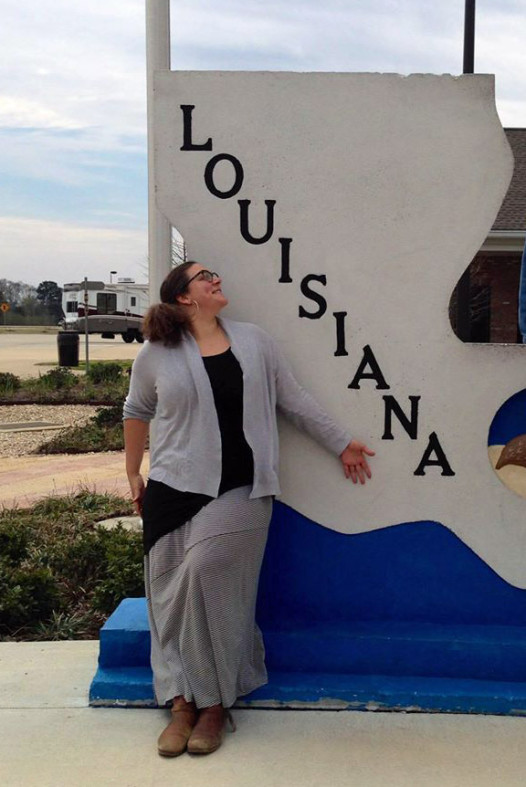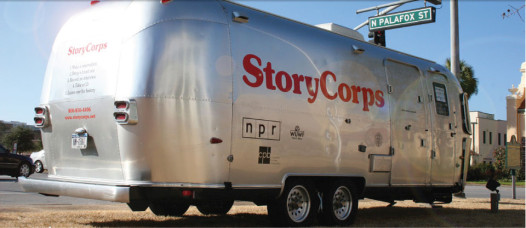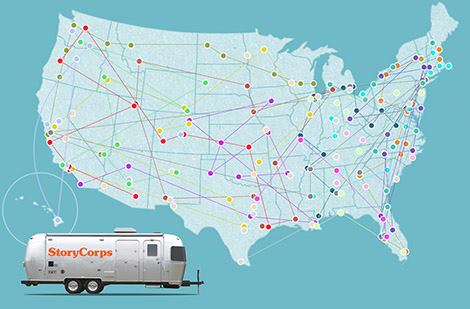
StoryCorps site manager Emily Franssen hits the Louisiana line (Photo: facebook.com/storycorps)
In other cities, parking in the lot at a local furniture store wouldn’t be on the StoryCorps radar. But this is New Orleans, where family-owned, multi-general businesses like Doer Furniture are linchpins of the neighborhood.
So lately, StoryCorps site manager Emily Janssen has been chatting with the people passing through this edge of Marigny. It’s a walkable kind of place, so joggers and bicyclers and residents out for a stroll have been stopping by to say hello and welcome and ask about the shiny silver Airstream trailer that has landed for the next few weeks in their part of the world. And, Janssen adds, she’s been meeting lots of dogs. Lots and lots of dogs.
“There are so many logistics involved with a StoryCorps site that being in a neighborhood is more of a rarity,” Janssen says. “But this has been a very happy change from the norm.”
Making those kinds of personal connections is what StoryCorps is all about. Since 2003, the nonprofit organization has been soliciting one-on-one conversations from people across the country, in one of the largest oral history projects of its kind.
But, while most of the StoryCorps interviews are archived at the American Folklife Center at the Library of Congress, the project is as much for the participants as a world audience, says Janssen. That, in fact, is what pulled her into it.
“I came from the world of direct service, working mostly with homeless youth,” Janssen explains. “That was my trajectory into StoryCorps. I had an interest in the way we tell stories, and seeing how marginalized and voiceless so many people in the world are. Being able to share your story, to be listened to, and the power of it, moved me.”
Sitting down and pouring out your heart to a friend or relative can be, well, pretty cathartic, Janssen says.
“Even if I go sit down and talk to my mom, just two people, it has the same power, And how often are we really sitting down and talking to each other? And really actually listening to each other?
“There’s something really special about coming into that space, and intentionally sitting down with someone you care about, and talking.”
Janssen’s own time in the booth illustrates the point. With a good friend, she says, “We just had this great conversation.” With her dad, she came away with a new awareness of him as a person. “I asked him to tell me something people don’t know about him, and he said something about loving dogs and babies. I’ve always remembered that, and it’s something I walked away with.”
StoryCorps participants are given a CD of their 40-minute session, with a friendly suggestion to copy it, pass it around, listen to it.
“Part of what I loved about talking to my parents is that later on, it will be important. And another thing that’s beautiful is just having the sounds of their voices, the way they speak.” It’s like an audio photograph, she says.

The StoryCorps airstream trailer makes 10 stops a year.
StoryCorps differs from traditional oral history projects by not using a professional interviewer, but rather having one person interview someone he or she knows. But the process is formatted in a way that keeps it from being just an oral selfie.
Each session yields an uninterrupted 40 minutes of recording, but two StoryCorps facilitators are on hand. One takes notes and keeps track of tags and search words for later searchable cataloging. The other monitors the technology, oversees the conversation and can gently move things along.
“How much you jump in depends. You have a sense of what they want to get out of this, so we can help that along. It may mean we don’t say a thing, but sometimes we do say more.”
Once they have a StoryCorps appointment, each interview couple gets a follow-up phone call to explain the process and offer pointers.
“Sometimes people ask us about things like profanity, and we say, ‘It’s your recording. We’re not censoring you.’”
The one thing facilitators never do, Janssen says with a laugh, is make assumptions about the upcoming session. Topics are constantly suprising, and “people shift your perspective constantly.”
“We often get similar questions, but the answers follow different paths,” says Janssen. “Where are you from? What about your childhood shaped you? In 40 minutes you can’t do anyone’s whole life, so people tend to probe about what matters.”
She recalls one interview between a case manager and an adolescent that centered on a conversation about Walking Dead. “That was their common denominator.”

Stories all over the map (Photo: storycorps.org)
In New Orleans, Hurricane Katrina comes up often, not because StoryCorps is soliciting those stories, but because it is so often a pivotal point in people’s lives here. Kids, she says, are a favorite, “because they ask brilliant questions. Things like, if there were no animals in the world, how different would your life be? Or incredibly honest questions, like, do you like my sister better than me?”
Participants can elect to have their sessions made available to the public, either just as an entry in the Library of Congress archive, or as something StoryCorps can use in various projects, such as podcasts, animations or books. In New Orleans, as at other stops, some of the stories will be shared in short spots on WWNO public radio, the local NPR affiliate. Currently, the main archive of more than 58,000 recordings in Washington D.C. can only be accessed and researched in person; Janssen hopes that someday it will be available and searchable online as well.
Some participants are natural storytellers, says Janssen, while others are more nervous in front of the microphone.
“But it’s very freeing not to worry about being videotaped. You don’t have to think about how you look.”
StoryCorps maintains permanent booths in San Francisco, Chicago and Atlanta. The Airstream trailer makes 10 stops a year, accompanied by a trio of crew members who travel in a pair of cars. The schedule allows for seven interviews a day.
The mobile program allows for wide geographical and population diversity. It underscores, says Janssen, how much people are alike. And not.
“It really does break down barriers and assumptions,” says Janssen of listening to people from diverse parts of the country and backgrounds. “We’re all going through life and dealing with the same things, so we’re incredibly connected, and I see the beautiful way that the color of that, what it looks like, is so different. Here in New Orleans, what’s inside you, that culture, comes out in the way you talk and share your experiences. Environment does shape people.:
All the recordings she has facilitated, says Janssen, have something unique to offer.
“People often have the misconception that they don’t have a story to tell. But it’s really not about the dramatic stories. And it’s not one story. It’s a conversation.”
Like earthenware pottery shards at an archeological dig, “sometimes it’s the really mundane things about our lives that make for true oral history.”
Whether you are signed up for the StoryCorps project or not – the schedule is full, but you can put your name on a wait list – Janssen recommends the process to everyone.
“Go have coffee with someone and turn off all your devices and actually look at each other and talk for 40 minutes. Sometimes that’s the best gift we can give.”
There’s an app for that: Download the StoryCorps mobile app for a self-recording, which you can share with the world, at storycorps.me.
WWNO radio, 89.9 FM, is broadcasting select interviews from the StoryCorps session in New Orleans. Find the station’s archived stories from Storycorps’ 2010 visit here.
 New Orleans Startups
A brief overview of the growing New Orleans startup scene. This piece highlights the main industries of New Orleans, competing cities, and just how emerging the current entrepreneurial/startup scene is in New Orleans.
New Orleans Startups
A brief overview of the growing New Orleans startup scene. This piece highlights the main industries of New Orleans, competing cities, and just how emerging the current entrepreneurial/startup scene is in New Orleans.
 A Bin in Every Classroom: Why Tulane Should Lead on Composting
I asked a peer, Isabel, for her thoughts on composting: “Why do...
Tulane
A Bin in Every Classroom: Why Tulane Should Lead on Composting
I asked a peer, Isabel, for her thoughts on composting: “Why do...
Tulane